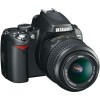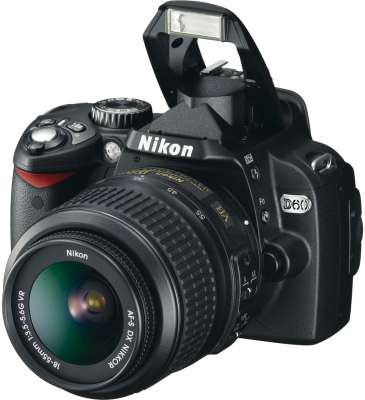- Qualcomm Launches Snapdragon 4 Gen 2 Mobile Platform
- AMD Launches Ryzen PRO 7000 Series Mobile & Desktop Platform
- Intel Launches Sleek Single-Slot Arc Pro A60 Workstation Graphics Card
- NVIDIA Announces Latest Ada Lovelace Additions: GeForce RTX 4060 Ti & RTX 4060
- Maxon Redshift With AMD Radeon GPU Rendering Support Now Available
Nikon D60 10.2MP Digital-SLR Camera

Targeting newer photographers, the Nikon D60 is priced right and includes a fantastic feature set. On top of the 10MP sensor, the D60 includes an automatic sensor cleaner, a vibration reduction kit lens, fast 3FPS performance, high ISO modes and a lot more.
Page 6 – Final Thoughts
|
|
When I first saw the press release for the D60, I wasn’t sure what to think. Its specs come so close to the D40x, that it was just made so confusing. But after taking a look around, it seems that the D40x is harder than ever to find in stock at popular camera e-tailers, while the original D40 is still readily available. This makes sense in a lot of ways, since the D40 does have specs quite different than the D60.
For the price-range (~750USD w/lens), the D60 is one of the best D-SLR’s available. It comes packed with a lot of potential for either the novice or professional, is made simple to use, is built to last and is compatible with all of Nikon’s accessories and F-mount lenses.
The value for a D-SLR nowadays is high. For ~$750, the D60 is available with the 18-55mm lens and right out the door is ready to take some great shots. It’s too bad that external flashes never seem to go down in price, though. $200 is a tough decision to make, but one almost everyone will make at some point. Even third-party flashes are not much cheaper, so it’s a decision that you have to suck up.
But aside from that, the price is right, and that’s what’s important. For those looking for a slightly more robust camera, an extra $200 could deliver a camera better suited to you. On one popular e-tailer, for example, the D80 with the same lens we used here is selling for $899… $170 more than the D60 kit. What that avails you is a camera with more flexibility and a better design. But, it’s also larger, which might defeat the purpose for a few people. The same goes for Canon’s new XSi, which sells for around $800, body only.

But I digress, because as it stands, the D60 is a fantastic shooter, and one I became impressed with quite fast. When I reviewed the Nikon D40x, I enjoyed the camera, but it never really “grabbed” me. The D60 did grab me, for whatever reason. Even though it’s is similar to the D40x, I enjoyed using the D60 more. Maybe it felt more sturdy. Maybe I subconsciously hate the letter X. I don’t know.
Although I didn’t delve into all of the available features, the D60 is rather comprehensive for the price range. It contains a sensor cleaner, which is nice (although I’ve never used one long enough to know the benefits) and the image resolution over the D40 is fantastic. Understandably, many may not take advantage of 10MP images that often, but when you need to crop a small part of an image, you appreciate having a large image to deal with.
It’s a small issue, but one thing that bugged me about the D60 is that there is no “USB Mass Storage” mode… PTP only. That means that the camera cannot be connected to the computer and accessed as a regular USB storage device, but rather, you will need some third-party application or use Windows built-in photo management tool to extract the images. This won’t bother many people, I’m sure, but for those power-users out there, it might rub you the wrong way.
Another gripe is that when shooting in RAW, JPEG Basic is the only quality setting available. By comparison, higher-end models allow RAW+JPEG Fine, which assures that you get a high quality JPEG as well. With JPEG Basic, the quality will suffer in some regards. That’s taken care of by editing the RAW itself and exporting to a JPEG, but that’s still some needless work for something so simple.
Still, that all aside, for the price range, the D60 is a fantastic offering, and if I had a need, I’d gladly pick it up as a backup camera. It’s small frame makes it easy enough to bring anywhere, and even those who hate lugging a lot of weight on their shoulders shouldn’t have to worry, since the basic lens and camera body amount to just under 2lbs.
For anyone looking to take photography a little more seriously, the D60 is a great choice. If money is not particularly an issue, then I’d recommend a higher-end model, but like any camera purchase, it’s highly recommended to go straight to a camera store and test out the different models yourself. Folks at camera shops are usually more than happy to help in this regard and can make your purchase decision much easier.
- Pros
- Lightweight D-SLR offering
- Good pricing for the performance and quality ($750USD)
- Fast shooting performance (3FPS burst)
- Feature-packed, high ISO settings
- Kit lens includes Vibration Reduction
- Works well in low-light situations
- Uses ultra-affordable SD/SDHC memory cards
- Solid design; built like a tank
- Built-in sensor cleaner
- Great battery-life
- Up to ISO 800 results in good quality
- Similar sensor to big brother D80
- Cons
- No second dial to make setting changes easier
- No USB Mass Storage mode
- No RAW+JPEG Fine setting
- No live view mode, despite being a popular feature
- VR not built into body
- No button for simple ISO changing
If you have a comment you wish to make on this review, feel free to head on into our forums! There is no need to register in order to reply to such threads.

|
|
Support our efforts! With ad revenue at an all-time low for written websites, we're relying more than ever on reader support to help us continue putting so much effort into this type of content. You can support us by becoming a Patron, or by using our Amazon shopping affiliate links listed through our articles. Thanks for your support!





